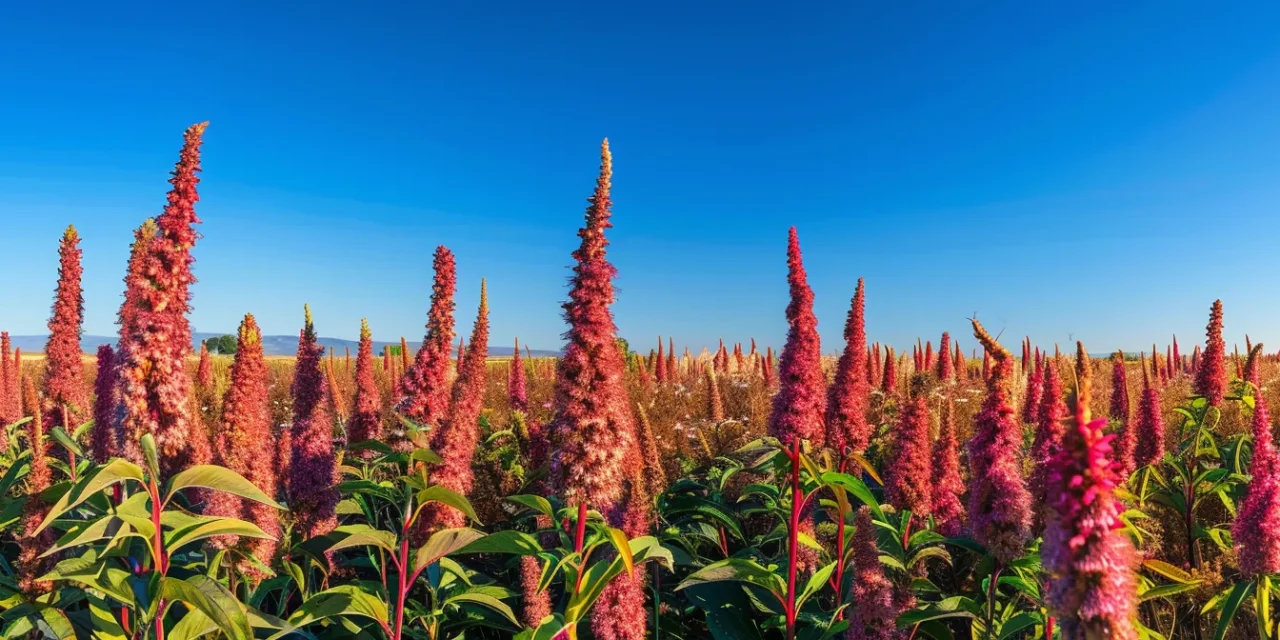Amaranth, the once-revered grain of the Aztecs, is finding its way back into our pantries and onto our plates. For those aiming to enrich their healthy diet with a nutrient-dense yet underappreciated supergrain, amaranth offers a wealth of benefits, including high fiber content and a versatile portfolio beyond mere sustenance. Drawing from South America‘s rich agricultural heritage, this resilient crop serves not only as a hearty porridge but also as a vibrant dye. Here, we’ll dive into its storied past, unpack its impressive nutritional profile, and guide you through an array of culinary applications for this adaptable ingredient. Whether you’re a home gardener or a culinary enthusiast, understanding how to harness amaranth‘s potential can transform your approach to wellness and flavor.
The Ancient Origins of Amaranth: A Supergrain Through the Ages

The remarkable grain known as amaranth has deep roots tracing back to early civilizations, where it stood as a staple crop—integral in diets just as essential nutrients like dietary fiber and complete protein are today. As I delve into its cultural significance, you’ll discover how it was revered in Aztec and Incan traditions, the intriguing historical uses and practices surrounding amaranth, and witness its modern revival, drawing parallels to foods like buckwheat that have found new appreciation in contemporary diets. These insights reveal not just the past importance of amaranth, but also its enduring versatility and benefits.
Amaranth in Early Civilizations: A Staple Crop
Amaranth was more than just a common crop in early civilizations; it was a cornerstone of ancient agriculture that symbolized healthy nutrition. This ancient grain was cultivated extensively by the Aztecs, who recognized the seeds of amaranth not only as a staple ingredient in their daily meals but also as a part of their cultural rites. They valued its nutritional benefits, which aligned with what we understand today about its rich protein content and vital micronutrient composition.
My fascination with amaranth stems from its impressive versatility—a trait that has endured for thousands of years. As a crop, it demonstrated a remarkable resilience in various climates and soil conditions, making it a reliable source of sustenance for early societies dependent on agriculture. The seeds of amaranth were ground into flour, popped like corn, or even mixed with honey to form traditional dishes that persisted as healthy meal options through the ages.
The historical significance of amaranth in early civilizations cannot be overstated. I have uncovered records and artifacts during my research that illustrate its status as a supergrain, far before the term became a modern buzzword. Its endurance through millennia speaks volumes about its ingrained role in human nutrition and showcases amaranth‘s perennial contribution to global agricultural practices, reinforcing my dedication to its study and propagation in our diets today.
Cultural Importance in Aztec and Incan Traditions
During my exploration of ancient grains, I’ve been drawn to the profound cultural significance of amaranth within Aztec and Incan societies. To the Aztecs, amaranth was not just a food source; it was a sacred plant that played a key role in religious ceremonies. The oil extracted from amaranth seeds was used in rituals, and the grain itself was crafted into deities’ effigies, symbolizing the intertwining of spirituality and nourishment—a concept resonant with today’s understanding of food’s role in holistic well-being.
Amaranth‘s importance stretched beyond mere sustenance for the Incas, where it was one of the few crops celebrated as a ‘pseudocereal‘ due to its grain-like qualities despite being a seed. It was pivotal to their diet, much as manganese—an essential nutrient found in amaranth—is to ours. They recognized this plant‘s resilience and nutritional power, cultivating it meticulously in their grooves, and it became instrumental in fortifying their society against the demands of the harsh Andean environment.
The cultivation and consumption of amaranth were deeply rooted in these sophisticated civilizations partly due to its remarkable nutritional profile, which includes a balanced amino acid composition essential for human health. Reflecting upon this, I’m struck by the continuity of our quest for wholesome foods and the timeless relevance of amaranth. Its resurgence in modern diets is a testament to the wisdom of these ancient traditions, reminding us that what nourished our ancestors still holds substantial value today.
Historical Uses and Practices Surrounding Amaranth
My research into amaranth has shed light on its historical applications, providing context for its resurgence in modern diets. Similar to its cousin quinoa, amaranth was a central element in dishes ranging from nourishing stews to rich salads, and was often combined with other sources of protein such as beans. This combination not only offered a culinary delight but also ensured a diet high in iron and other essential minerals. Amaranth‘s adaptability allowed it to be a culinary staple across various civilizations—its seeds formed the basis of ancient recipes that have been passed down through generations and continue to inspire today’s culinary innovations.
The ways in which ancient cultures prepared amaranth are particularly fascinating to me, revealing the grain‘s unrivaled versatility. Popped amaranth was a favorite akin to a nutritious snack, while its flour was used to create a traditional bread that provided an energy-rich food source. In some regions, reminiscent of a spicy chili pepper sauce, amaranth was incorporated into condiments and seasonings, enhancing flavors while boosting the nutritional profile of countless meals. These practices provide actionable insights into how we can reintroduce amaranth to our diets, using it as a base for salads, sides, or infusions in sauces for a healthful twist on traditional dishes.
Considering the ancient rituals and practices, it’s clear that amaranth‘s role extended beyond the plate. In my explorations, I’ve been captivated by how these societies understood and exploited the bean‘s diverse qualities. Amaranth‘s significance was deeply woven into the fabric of daily life, evidenced by its use in ceremonial offerings and as a sign of prosperity. Understanding these historical contexts enriches our appreciation for amaranth and informs how we can thoughtfully integrate this supergrain into our own lifestyles for enriched nutrition and a nod to a rich cultural past.
Revival of Amaranth in Modern Times
In my experience, the revival of amaranth in our times is a remarkable journey of rediscovery. This nutritious grain, once central to the Aztecs, is regaining popularity as a versatile ingredient in modern kitchens. Rich in vitamins and minerals, amaranth is finding its way into soups, salads, and as a nutrient-dense leaf vegetable, meeting the growing demand for wholesome, plant-based foods.
Having engaged with culinary enthusiasts and dietitians, I’ve witnessed the reimagination of amaranth beyond traditional uses. Its gluten-free profile complements contemporary dietary needs, while the tiny seeds contribute a pleasant texture to dishes. I’ve seen it being transformed into a healthful soup thickener or used whole to add a crunch to salads, showcasing the grain‘s flexibility and its value in a nutritious diet.
Reflecting on the historical significance of amaranth, I’m heartened by its modern resurgence. As people seek out foods that fuel their bodies and honor our collective heritage, amaranth stands out. A leaf vegetable in some cultures, a pseudo-grain in others, it embodies the spirit of the Aztecs in today’s quest for nutritionally rich foods, embodying the past while forging a path to a healthier future.
From the terraced hills of ancient civilizations, amaranth has endured. Now, let us examine its power to nourish our bodies in the present.
Nutritional Benefits of Amaranth: A Comprehensive Overview

Focusing now on the healthful attributes of amaranth, I’m eager to impart the full spectrum of its nutritional wealth. Brimming with a high protein content and essential amino acids, amaranth supports muscle maintenance and overall vitality. It’s a treasury of vitamins and minerals, including calcium, to bolster optimal health. Additionally, as a fiber-rich grain, it aids digestion, while its antioxidant properties enhance immune function. For those on gluten-free diets, amaranth is a fitting and nutritious honey-like grain, serving as a perfect snack or meal addition, packed with protein and key nutrients to fuel the body.
High Protein Content and Essential Amino Acids
In my exploration of the nutritional spectrum of amaranth, I’ve been consistently impressed by its protein content, which is notably higher than that of rice, a common staple in North America and around the globe. The essential amino acids present in amaranth, such as lysine, which rice lacks, are critical for building proteins within our body. They are vital for tissue repair and immune system function, making amaranth a nutrient-dense addition to one’s diet.
As someone closely tracking nutrition trends and scientific findings, I’ve taken note of studies suggesting that amaranth‘s amino acid profile may play a role in cancer prevention. Dietitians are starting to recommend amaranth as part of a balanced and diverse diet, not only for its potential in battling chronic diseases but also because it serves as an excellent source of plant-based protein for vegetarians and vegans alike.
My own integration of amaranth into meal plans provides a practical example of how this ancient grain can enhance a modern diet, leveraging its complete protein profile. Replacing rice with amaranth in dishes has assisted clients in increasing their intake of high-quality protein without relying on animal products, thereby enriching their nutrient consumption and potentially contributing to overall health and longevity.
Rich in Vitamins and Minerals for Optimal Health
Investigating amaranth‘s robust vitamin and mineral profile, I’ve learned that it’s rich in B vitamins, particularly folate, which plays a vital role in cellular health and metabolism. From its origins in the Americas, specifically Mexico, this supergrain has carried these nutrients through centuries of cultivation. A serving of amaranth can deliver a significant portion of the daily recommended intake for these micronutrients, contributing to managing cholesterol levels and supporting overall cardiovascular health.
As I share recipes with clients and fellow food enthusiasts, I emphasize amaranth‘s mineral wealth, including calcium for bone health, magnesium for muscle function, and iron for oxygen transport. This grain‘s nutrient density supports a myriad of bodily functions, making it a powerhouse ingredient in a diverse range of dishes. Encouraging busy individuals to incorporate amaranth into their meals, I’ve seen firsthand the positive impacts on their nutrition and energy levels.
One of my career’s commitments as a nutrition professional has been to furnish people with the knowledge needed to make informed dietary choices. If you’re desiring to skip to content that not only tantalizes the taste buds but also fortifies the body, look no further than amaranth. Integrating it into your diet—as a hearty porridge, a salad topping, or as a rice substitute—can help maintain optimal health, reducing the risk of chronic conditions and providing essential nutrients that fuel our daily activities.
Fiber-Rich Grain Supporting Digestive Wellness
In my study and application of amaranth, I’ve found its high fiber content to be instrumental in supporting digestive wellness. Amaranth, as a gluten-free whole grain, offers a substantial amount of dietary fiber that aids in maintaining a healthy digestive system. Its texture and subtle taste complement a vast array of dishes, allowing for easy integration into daily meals, supporting those with gluten sensitivities to enjoy diversified, nutrient-rich menus without compromise.
Through my work with clients, I’ve observed that including amaranth can contribute to a feeling of fullness, which assists in managing weight effectively. This ancient grain‘s rich fiber profile promotes regular bowel movements while helping to prevent constipation. In addition, the presence of Vitamin B6 in amaranth supports carbohydrate and fat metabolism, further underlining this supergrain’s role in a balanced, health-conscious diet.
During consultations, when discussing mineral intake, I often highlight that amaranth is not only about maintaining digestive health but also about contributing to a holistic approach to wellness. Amaranth provides a meaningful contribution of essential minerals alongside fiber, making it a dual-acting ingredient for those seeking to optimize their digestive function while also ensuring they receive the minerals necessary for their body’s overall performance.
Antioxidant Properties Boosting Immune Function
In my professional exploration of amaranth, I’ve noted its abundance of antioxidants, which play a substantial role in bolstering the body’s immune function. Unlike wheat, amaranth contains noteworthy levels of health-promoting compounds like flavonoids and squalene, which are known to fight against oxidative stress and may reduce the risk of chronic diseases.
Considering the versatility of amaranth, it’s comparable to maize in the sense that both are ancient cereals revered for their nutritional value. However, amaranth, sometimes consumed as a leaf vegetable in dishes like callaloo, goes beyond its grain counterpart in offering a spectrum of antioxidants. These attributes suggest amaranth is well-equipped to support the body’s defenses.
Through the inclusion of amaranth in my diet, I’ve personally witnessed an improvement in my overall well-being. It’s a testament to the grain‘s phytochemical-rich profile that aids in immune support, setting it apart from traditional cereals and positioning it as a valuable food for maintaining health and preventing illness.
Suitable for Gluten-Free Diets
In my experience, amaranth flour has become a crucial ingredient for those following a gluten-free diet. Its naturally low calorie content and absence of gluten make it an ideal alternative for wheat flour when cooking. Many dietitians recommend it to their clients who are sensitive to gluten, as it can be readily used in a variety of recipes without compromising taste or texture.
Integrating amaranth into gluten-free diets has been seamlessly effective in my practice. I’ve found that when mixed with water, amaranth flour creates a versatile dough that retains moisture and binds well, properties highly valued in gluten-free cooking. This adaptability appeals to individuals who desire to explore and enjoy a broader spectrum of culinary delights, despite dietary restrictions.
Through discussions with individuals managing gluten intolerances, I’ve learned amaranth‘s high nutritional profile, including its protein and fiber content, provides sustenance without the fear of gluten contamination. Furthermore, the ease at which amaranth can be incorporated into daily meals ensures those on gluten-free diets receive balanced and fulfilling sustenance, affirming the advice many dietitians—and I—give regarding this ancient supergrain.
Now, understanding the healthful power of amaranth, you might wonder how to make it part of your routine. Let’s walk through simple ways to fold this ancient grain into your daily fare, enhancing meals with both nutrition and taste.
How to Incorporate Amaranth Into Your Everyday Meals

As we continue to explore the diverse applications of Amaranth, particularly the species Amaranthus hypochondriacus, we’ll delve into practical ways of incorporating this health-promoting grain into daily meals across various cultures, including Africa, where its virtues in botany and nutrition are well-regarded. I’ll guide you through cooking techniques to prepare amaranth perfectly every time, offer creative breakfast ideas, introduce versatile lunch and dinner recipes, share tips for baking with amaranth flour, and suggest snack options to fully utilize this genus‘s potential in your diet.
Cooking Techniques for Perfect Amaranth Every Time
In my practice of incorporating amaranth into everyday diets, I’ve found that mastering the technique of cooking this grain is crucial for optimal enjoyment and nutrient retention. Amaranthus cruentus, harvested at its peak, delivers not just flavor but also a wealth of nutrients akin to those found in soybean, another protein-rich crop. A simple yet effective method I advise is to toast the grains lightly in a dry pan before simmering in water, which enhances the natural nuttiness while ensuring the amaranth cooks evenly.
For those in the Caribbean and beyond looking to embrace the domestication of ancient grains like amaranth in their kitchen routines, the water-to-grain ratio is key. I have achieved consistently great results with a mixture of one and a half cups of water to a half cup of amaranth, brought to a boil and then simmered for 20 minutes. The grains should be tender yet firm to the bite, much like al dente pasta, offering versatility for a variety of culinary applications.
Through my explorations of this crop‘s rich history, from traditional roles in Caribbean diets to its recent rebirth in health-conscious households, I’ve learned the importance of precise cooking times for amaranth to maintain its nutritional integrity. A simmer of 20-25 minutes is ideal, avoiding overcooking which can lead to a loss of valuable nutrients. By following these simple cooking principles, amaranth becomes a versatile and nourishing addition to any meal.
Breakfast Ideas Featuring Amaranth
Beginning the day with a bowl of warm amaranth porridge sets a nourishing tone for the morning. I’ve found that its naturally nutty flavor pairs wonderfully with a drizzle of honey and a handful of fresh berries, providing an energy-boosting breakfast rich in phosphorus, which aids in bone health and energy metabolism. This delightful dish is not only a nod to ancient grains but also a boon for the immune system, offering the necessary kick-start to daily activities.
Amaranth can also be utilized as a creative alternative to oat in breakfast bars. After experimenting in my kitchen, I’ve perfected a recipe that combines popped amaranth with nuts and dried fruits, resulting in a portable and convenient snack. These bars are a powerhouse of nutrients, featuring amaranth‘s complete protein profile and essential amino acids that are vital for maintaining muscle health and overall vitality throughout the day.
For a savory twist, I often recommend incorporating amaranth into morning veggie patties. When combined with whisked eggs and a blend of vegetables like spinach and tomatoes, amaranth provides texture and substance to these patties. This protein-packed breakfast option, rich in fiber and phosphorus, not only pays homage to the versatility of ancient grains but also fortifies the body, sustaining energy levels until the next meal.
Lunch and Dinner Recipes to Try
Introducing amaranth into lunch and dinner recipes has provided me with not only a delightful texture but has also been an incredible way to boost potassium intake. One of my go-to dishes is a hearty amaranth grain risotto, where I replace traditional rice with amaranth, enriching the dish with earthy flavors and significantly upping the nutritional value. In witnessing how versatile this species, Amaranthus retroflexus, can be, it’s become a staple food in my kitchen for its remarkable adaptability.
For those evenings when I crave something lighter yet fulfilling, I often prepare a chilled amaranth salad. Here, amaranth grain comes to the fore, mingling with crisp vegetables and a tangy vinaigrette. The meal is not only satisfying but also provides an array of nutrients, from fiber to essential minerals, reinforcing amaranth‘s role as a foundational food that supports a holistic approach to nutrition.
My culinary adventures have led me to find that amaranth flour makes a perfect thickener for soups and stews. Not only does this enhance the texture, but it also boosts the overall nutrient profile of the meal. By integrating this ancient grain into my savory dishes, I fortify my diet with a plant-based source of protein and essential vitamins, turning everyday meals into a celebration of both flavor and wellness.
Baking With Amaranth Flour: Tips and Tricks
When baking with amaranth flour, I’ve discovered it’s wise to begin by blending it with other flours to manage the heat and avoid a raw taste. Amaranth flour, rich in magnesium, can enhance the nutritional profile of baked goods in the United States, where diets often lack this critical element for regulating blood pressure. Familiarizing oneself with the flour‘s behavior through mixing it with tried-and-true options like wheat or almond flour offers a balanced approach to texture and flavor.
In my practice, I’ve found that using amaranth flour can be particularly rewarding in vegetable-based baked goods, where its natural earthiness complements savory flavors. It provides a good source of magnesium, a mineral essential for over 300 biochemical reactions in our bodies, which many of my health-conscious clients in the United States are eager to integrate into their diets to boost heart health and manage blood sugar levels.
Through my personal culinary experiments, I’ve learned that careful attention to moisture is key when baking with amaranth flour. Because it doesn’t behave like traditional wheat flour, introducing additional liquids like vegetable oils or eggs can help in creating the right consistency, which is especially beneficial in gluten-free recipes. This adjustment not only improves the texture of the final product but also the incorporation of amaranth enhances the blood-supporting iron content of the baked goods.
Snack Options Utilizing Amaranth
In my exploration of amaranth‘s versatility, I’ve experimented with creating snack options that are not only nutritious but also convenient for busy lifestyles. Amaranth, similar to millet in its ancient grain classification, can be transformed into energy bars when mixed with seeds, nuts, and dried fruit. Such snacks offer a lasting energy boost, feed the body with essential nutrients, and are perfect for gardening enthusiasts looking for a quick bite to sustain their outdoor activities.
The seeds of amaranth, a component of this resilient crop, serve as an excellent base for homemade granola. By toasting them lightly and combining them with a medley of seeds and natural sweeteners, I’ve crafted granola that rivals store-bought varieties both in flavor and nutritional content. This simple, homemade option fits seamlessly into a health-minded garden picnic or as an everyday snack to satiate mid-day hunger pangs with a fiber-rich treat.
While working with clients who prefer to grow their own foods, I’ve introduced puffed amaranth as a top-tier snack choice. Just as a garden is a mixture of variety and vitality, so too can puffed amaranth be a lively addition to yogurt or fruit cups—adding a satisfying crunch without the need for artificial additives. It’s through such kitchen gardening that we bridge the gap between the ancient uses of this crop and our contemporary snacking habits, cultivating a new appreciation for amaranth‘s seed-to-snack versatility.
The story of amaranth in our meals has only begun. Beyond the stove, this grain harbors more talents waiting to be unearthed.
The Versatile Uses of Amaranth Beyond the Kitchen

Expanding our appreciation for amaranth, we uncover its myriad applications beyond the culinary sphere. Utilizing amaranth leaves in dishes adds nuance to a healthy diet, while amaranth oil serves both nutritional and therapeutic purposes. Its vibrant colors make excellent natural dyes, with methods I’ve refined over time, and its role in traditional medicine is underscored by its healing properties. Even in the realm of beauty, amaranth infusions enhance products, a testament to the grain‘s timeless versatility. Let’s explore these practical uses, tapping into the supergrain’s full potential.
Utilizing Amaranth Leaves in Culinary Dishes
In my culinary practices, I’ve discovered that amaranth leaves are more than just an accompaniment to grains; they stand out as a versatile green in their own right. Cooking amaranth leaves, which can be both tender and toothsome, adds a nutritious spin to familiar dishes like stir-fries and salads, enhancing meals with their minerality and vitamins, particularly Vitamin A, which is pivotal for vision and immune health.
When I weave amaranth leaves into culinary dishes, they transform a simple meal into a nutrient-dense experience. My go-to technique for drawing out their vibrant flavor is a quick sauté with garlic and olive oil, allowing these greens to complement proteins or serve as a hearty stand-alone dish, brimming with wholesome fiber and essential micronutrients.
Exploring the culinary range of amaranth leaves has led me to use them as a robust alternative to other leafy vegetables, such as spinach or kale. They lend a subtle earthiness to soups and stews, and when blended into a smooth puree, they offer a rich source of iron and calcium, vital for maintaining strong bones and supporting muscle function.
Benefits and Applications of Amaranth Oil
In my study of amaranth oil, I’ve recognized its remarkable anti-inflammatory properties, which stem from the rich concentration of squalene and unsaturated fatty acids. These compounds are known to alleviate conditions such as eczema and psoriasis, making amaranth oil a valuable addition to the natural health practitioner’s toolkit. Regular topical application can potentially ease inflammatory skin conditions, providing comfort and promoting skin health.
Delving further into the nutritional angle, amaranth oil derives its benefits from a bounty of vitamins, especially vitamin E, which acts as a powerful antioxidant. This attribute of amaranth oil aids in neutralizing free radicals, protecting cellular health and potentially slowing the aging process. It’s a sought-after ingredient in my dietary recommendations for those focused on boosting their antioxidant intake through natural, plant-based sources.
Incorporating amaranth oil into daily routines, I’ve observed its impact as a dietary supplement for heart health. The omega-3 and omega-6 fatty acids present in the oil contribute to maintaining a healthy cholesterol balance, which is essential for cardiovascular wellness. My own use of amaranth oil in meal preparation has allowed me to enrich dishes with a nutty flavor while simultaneously imbuing them with these heart-protective qualities.
Amaranth as a Natural Dye: Methods and Uses
In my experience working with natural dyes, I’ve found amaranth to be particularly useful for its vibrant color payoff. The intense red hue derived from amaranth is not only visually striking but also boasts a longevity that synthetic dyes can’t match. By boiling the leaves and flowers, you can extract a concentrated dye that is perfect for fabric and crafting projects, presenting an eco-friendly alternative for artisans and textile enthusiasts.
One practical application of amaranth dye which has proven effective in my projects involves enhancing the color of botanical inks. The amaranth pigment adds depth and a unique vibrance to handmade inks used for calligraphy or painting, offering artists a wider palette of natural tones. This utilization underscores amaranth‘s versatility and demonstrates its seamless integration into creative pursuits.
Moreover, the use of amaranth as a dye extends beyond textiles to food and cosmetics. In my consultations with manufacturers seeking natural alternatives, amaranth‘s appealing color spectrum has become a sought-after solution for coloring lip balms, soaps, and even pastries. Its ability to impart rich color without compromising on healthiness or quality is especially valued in an industry moving towards clean, sustainable ingredients.
Role of Amaranth in Traditional Medicine
In my engagements with traditional healing practices, I’ve discovered that amaranth has been used medicinally for centuries to treat a variety of ailments. Its leaves and grains, rich in minerals and vitamins, have been consumed to strengthen the immune system and promote healing. This ancient wisdom aligns with modern nutrition science, which underscores the immune-supporting nutrients found in amaranth such as vitamin C, iron, and zinc.
The application of amaranth in traditional medicine often involves using the seeds as a diuretic to manage fluid retention and kidney health. I’ve observed this practice in various cultures where amaranth is grown, where its natural properties are harnessed to support urinary tract health and prevent complications. The trust placed in this supergrain by our ancestors points to its genuine effectiveness, something I continually consider in diet and wellness discussions.
Additionally, I’ve noted that amaranth oil has been topically applied to the skin to encourage healing and reduce inflammation, a practice that reflects its rich content of squalene and omega fatty acids. These components are known for their skin-reparative and anti-inflammatory effects, making amaranth a valuable plant not just for consumption but also for external therapeutic use. My research into traditional medicine has led me to appreciate amaranth as a comprehensive health aid beyond the kitchen.
Incorporation of Amaranth in Beauty Products
In my professional experience, amaranth has made significant strides in the beauty industry, thanks to its nutrient-rich profile. The incorporation of amaranth oil, specifically, into skin care products harnesses its high linoleic acid content, which is known to fortify the skin’s barrier and maintain hydration. I’ve advised clients with dry skin to seek out moisturizers that list amaranth as an ingredient for its exceptional emollient properties.
Through my work, I’ve noted a growing trend where beauty brands are integrating amaranth extract for its antioxidative benefits. Products infused with amaranth are shown to combat environmental damage and signs of aging due to the grain‘s richness in peptides and flavonoids. It’s become increasingly common for me to recommend these types of products to clients aiming to improve the resilience and vitality of their complexion.
The versatility of amaranth extends to hair care, where I’ve witnessed its positive impact on hair strength and luster. Shampoos and conditioners containing amaranth proteins contribute essential nutrients that can help to repair and protect hair follicles, reflecting my advice to those dealing with brittle or damaged hair. This application of amaranth illustrates the supergrain’s multifaceted role in not only health and nutrition but also personal care regimens.
Amaranth thrives quietly in the garden, not just the kitchen. Let’s turn the soil and sow the seeds for a harvest that lands on our tables with the same grace.
Cultivating Amaranth: From Garden to Table

As we turn our focus towards cultivating amaranth, I’m going to share my expertise on nurturing this resilient grain from seed to harvest. Delving into the ideal growing conditions and soil preparation sets the foundation for a thriving crop, as does following a deliberate, step-by-step planting and care guide. I’ll also discuss the best harvesting techniques to ensure maximum yield, the environmental impact of amaranth farming, and the importance of supporting local farmers and their communities.
Ideal Growing Conditions and Soil Preparation
My extensive experience in cultivating amaranth has shown me that this resilient grain thrives in warm climates, with ample sunlight being a pivotal factor in its growth. It’s critical to situate your amaranth in a spot that receives full sun for the majority of the day to ensure a bountiful harvest. The ideal temperature range for cultivating amaranth lies between 65 and 80 degrees Fahrenheit, which supports its robust growth and grain production.
In preparing the soil for planting amaranth, I’ve found that a well-draining loam offers the best results. Amaranth doesn’t require highly fertile soil, but working in some compost before planting can improve structure and nutrient content, setting a strong foundation for the crop. Keeping the soil’s pH within a neutral range of 6.0 to 7.0 promotes the best uptake of nutrients and reduces the likelihood of encountering growth issues.
Water management is another crucial aspect of growing amaranth successfully. I’ve learned that while this supergrain tolerates drought to a degree, maintaining consistent moisture during the early stages of growth is essential. However, it’s vital to avoid waterlogging the soil, as amaranth‘s roots are prone to rot in overly saturated conditions. Employing a balanced approach to watering, which accommodates both the plant‘s needs and the local climate, is key to fostering healthy development from germination through to harvest.
Step-by-Step Planting and Care Guide
In my practice of cultivating amaranth, the initial step involves sowing the seeds directly into warm soil after the last frost date has passed. I ensure that these minuscule seeds are planted no deeper than an eighth of an inch, with a spacing of about 10 to 12 inches between plants to accommodate their growth. Regular monitoring for seedlings is crucial, as amaranth tends to germinate within seven to fourteen days under optimal conditions.
As the amaranth seedlings develop, I prioritize thinning out the weaker plants, leaving the robust ones with ample space to flourish. This process, typically carried out when seedlings are a few inches tall, results in stronger plants that are less susceptible to disease and better able to access the nutrients and moisture they need. My attention to this detail has proven to be a decisive factor in nurturing a bountiful amaranth crop.
Maintenance for amaranth involves vigilant weed control and careful watering, practices I apply consistently in my gardens. The roots of amaranth are relatively shallow and can be outcompeted by invasive weeds, hence, gentle weeding ensures the soil remains undisturbed while protecting the plants. A disciplined approach to irrigation, providing regular but not excessive water, sustains the plants throughout their life cycle without water stress impeding their development.
Harvesting Techniques for Maximum Yield
In my own amaranth garden, I’ve discovered that timing the harvest is crucial for maximum yield. The amaranth grain heads are ready when they start to feel firm and the seeds can be easily shaken loose. By waiting too long, you risk seed loss or lower quality due to weather conditions; hence, observing the signs and acting promptly ensures the best harvest.
For the most effective collection, I gently rub the seed heads between my palms over a container or tarp to capture the tiny grains. This manual threshing method minimizes waste and allows for a thorough harvest. If you have a larger crop, using a screen can help to separate the seeds from the chaff, streamlining the process and saving valuable time.
After gathering the amaranth seeds, proper drying is imperative to prevent spoilage and maintain nutritional quality. I spread the harvested grains in a thin layer under the sun, stirring occasionally to ensure they dry uniformly. It’s this attention to detail during the post-harvest phase that can vastly improve both shelf-life and the quality of the amaranth seeds that make it to your table.
Sustainability and Environmental Impact of Amaranth Farming
In my experience, amaranth farming stands out as a beacon of sustainability within agriculture. This supergrain requires significantly less water compared to common crops like wheat and can grow in nutrient-poor soils, enhancing its viability as a crop in regions facing water scarcity and soil degradation. It’s these types of practices that embody responsible farming, prioritizing the health of ecosystems while providing nutritious food.
Recognizing the environmental impact of agriculture, I can affirm that amaranth‘s resilience to pests and diseases reduces the need for chemical pesticides. Its ability to thrive organically supports biodiversity and maintains soil health, which are critical factors in sustainable agriculture. Clients who integrate amaranth in their rotations often report not only increased soil fertility but also a reduction in their dependency on synthetic inputs, creating a win-win for the environment and farmer alike.
Guiding farmers towards eco-friendly practices, I’ve advocated for amaranth as a cover crop that can improve land use efficiency. Its dense foliage suppresses weeds, minimizing land disturbance and helping to prevent soil erosion—a common pain point in agriculture. By incorporating amaranth into farming systems, we take a step toward a more sustainable agricultural future, one that honors ancestral wisdom while addressing present-day challenges.
Supporting Local Farmers and Communities
My commitment to cultivating amaranth encompasses not just the harvest but also the support of local farmers and communities. By choosing to purchase amaranth from small-scale producers, we foster economic growth within our communities and contribute to a more sustainable food system. This engagement with local agriculture enriches our connection to food and its origins.
In conversations with local growers, I’ve seen the impact that community-supported agriculture (CSA) initiatives have on both farmers and consumers. When individuals invest in CSAs or farmers’ markets that supply amaranth, they ensure farmers a viable income and encourage the diversification of crops, which can lead to healthier diets and more resilient agricultural ecosystems.
Furthermore, I’ve been part of projects that introduce amaranth cultivation as a means to bolster food security in regions where malnutrition is prevalent. This versatile crop provides essential nutrients, reinforcing the role of smallholder farms in addressing nutrition challenges. Supporting these growers not only sustains their livelihoods but also promotes accessibility to nutritious foods like amaranth in underserved areas.
You’ve learned how to nurture amaranth and incorporate its versatility into your dishes. Let’s address the questions that might still linger in your mind about this resilient grain.
Frequently Asked Questions About Amaranth

In the following section, I’ll answer some of the most pressing queries surrounding amaranth, an ancient supergrain that has made a remarkable comeback in today’s healthy eating trends. We’ll examine amaranth‘s suitability for various diets, compare its nutritional profile to other grains like quinoa, and explore where to find and purchase amaranth products. Furthermore, I’ll discuss amaranth‘s potential in supporting weight management and address common allergies and sensitivities associated with it. In essence, these insights aim to deepen your understanding of amaranth and how it can fit into your daily life.
Is Amaranth Suitable for Everyone?
In my professional assessment, amaranth is largely suitable for a wide array of dietary requirements, including those who are gluten-intolerant or seeking vegetarian and vegan protein sources. Its natural gluten-free status makes it a safe and nutritious alternative to wheat-based grains, and its complete set of essential amino acids ensures it is a robust source of plant protein. However, as with any food, individual allergic reactions, although rare, can occur, and it’s wise to introduce amaranth gradually into one’s diet.
As a nutrition expert, I often recommend amaranth for those managing blood sugar levels or trying to improve cardiovascular health, thanks to its rich fiber content and beneficial unsaturated fats. I’ve seen many cases where incorporating amaranth has positively impacted clients’ health by aiding in cholesterol reduction and providing sustained energy without causing spikes in glucose levels. It’s also an excellent choice for individuals focusing on weight management, as it promotes satiety and is relatively low in calories.
I’ve encountered a few instances where people with sensitive digestive systems experience discomfort when consuming grains like amaranth, due to their high fiber content. This isn’t widespread, but it highlights the importance of tailoring diet advice to each individual’s unique health scenario. By paying attention to serving sizes and pairing amaranth with other foods that aid digestion, most can enjoy the benefits of this ancient supergrain without any adverse effects.
How Does Amaranth Compare to Other Grains Like Quinoa?
When comparing amaranth to quinoa, it’s noteworthy that both grains are complete proteins, offering all nine essential amino acids crucial for body functions. However, amaranth stands out for its higher lysine content, an amino acid less abundant in quinoa. This makes amaranth a superior choice for vegetarians and vegans looking to diversify their protein sources. Furthermore, amaranth‘s unique nutritional profile includes calcium, which is higher when compared to quinoa, benefiting bone health significantly.
In terms of culinary versatility, quinoa often earns praise for its fluffy texture and slightly nutty flavor, but amaranth provides a distinctive earthy taste and a creamy texture that can be particularly appealing in porridges and soups. My experience in using amaranth has taught me that its smaller grain size creates a delightful thickening agent for recipes, enhancing meals with its robust texture without overwhelming the dish’s inherent flavors.
From a farming perspective, I’ve observed that both amaranth and quinoa have similar sustainable attributes, such as a strong resilience in diverse climates and soil types. However, amaranth may have an edge with its relatively fast growth rate and ability to thrive even in less-than-ideal conditions, making it an attractive option for sustainable agriculture practices concerned with water usage and soil conservation.
Where to Find and Purchase Amaranth Products
Throughout my exploration of amaranth products, I’ve found that health food stores and specialty grocers are typically the best places to start your search. These outlets often offer a range of amaranth forms, from raw grains to flours and puffed varieties, catering to the needs of health-conscious consumers and those following specific dietary patterns.
In my professional experience, I’ve also seen a significant increase in the availability of amaranth products online. E-commerce platforms and websites dedicated to natural foods are convenient options for purchasing amaranth, providing access to a wider selection and often detailed product information, which can be particularly helpful for those new to using this nutrient-rich supergrain.
For those looking to support local agriculture, I recommend exploring farmers’ markets or connecting with community-supported agriculture programs in your area. Not only can you often find fresh amaranth leaves for culinary use, but you can also sometimes purchase the grains directly from the growers. Engaging with these local sources fosters community ties and ensures that you’re getting the freshest, most sustainable products available.
Can Amaranth Support Weight Management Goals?
As a professional well-versed in nutritional science, I can affirm that amaranth is considered supportive for weight management goals. Its high fiber content contributes to a sense of fullness, potentially reducing overall calorie intake by curbing frequent snacking and portion sizes. The slow digestibility of its complex carbohydrates also steadies blood sugar levels, preventing the spikes and dips that can lead to overeating.
In my experience advising clients on weight loss strategies, incorporating amaranth as a regular part of their diet has often yielded positive results. This ancient grain‘s protein richness provides the necessary nutrients to support muscle maintenance, a factor that is crucial in increasing metabolic rate and burning calories more efficiently. It’s this balance of high protein and fiber in amaranth that makes it an invaluable addition to a healthy weight management plan.
Moreover, clients have shared their success stories where transitioning to amaranth-based meals helped manage their hunger cues more effectively. Its versatility in recipes from breakfast porridges to dinner sides means amaranth can be easily included in any meal, aiding those committed to a structured diet plan in achieving their weight-related targets. Ensuring variety within their food choices, they’ve found amaranth to be not just nutritious but also delightfully satisfying.
Addressing Common Allergies and Sensitivities
In my professional experience, cases of allergies directly related to amaranth are uncommon, but awareness and caution when trying new foods like amaranth are advisable. If you suspect a sensitivity or have experienced a reaction, it’s essential to consult with a healthcare provider. Under their guidance, you might find ways to safely incorporate amaranth into your diet, or identify alternative grains better suited to your individual needs.
Understanding that digestive sensitivities can sometimes be mistaken for allergic reactions, I’ve guided clients through gradual introductions of amaranth into their diets. This approach allows the body to adjust to the high-fiber content, which could initially cause mild discomfort in sensitive individuals. It’s through these moderated experiences that we can determine amaranth‘s suitability for one’s digestion.
Lastly, for those with existing dietary restrictions or food allergies, I recommend thorough label reading when purchasing amaranth products. Cross-contamination with allergens can occur during processing, thus choosing certified gluten-free or allergen-free amaranth ensures safer consumption. This level of diligence supports individuals in enjoying the nutritional benefits of amaranth without compromising their health.
Conclusion
Amaranth stands out as a nutrient powerhouse and versatile ingredient, offering a complete protein profile, essential minerals, and antioxidants, which make it a viable option for a range of dietary needs including gluten-free and plant-based diets. Its resilience as a crop and minimal environmental impact endorse amaranth as a sustainable choice in agriculture, supporting the health of our planet and our bodies. The grain‘s deep historical roots and cultural significance are matched by its contemporary culinary adaptability, from traditional dishes to modern health-conscious cuisines. In embracing amaranth, we not only honor ancient wisdom but also contribute to a nourished, sustainable future.










